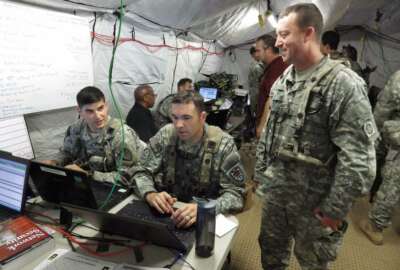
Army trying to keep up with ‘changing character of war’
As the Army shifts its focus from violent extremist organizations to near-peer adversaries per the national defense strategy, staying on top of emerging domains and...
Gen. Mark Milley, chief of staff for the U.S. Army, says the character of war is changing in real time, and the Army is trying to keep up with it. As it shifts its focus from violent extremist organizations to near-peer adversaries per the national defense strategy, Milley said staying on top of emerging domains and technologies will be what keeps the Army in a position of dominance going into the future.
Milley said during the June 21 Capitol Hill National Security forum that the nature of war hasn’t changed since ancient times: humans use force to try to impose their political will on opponents. That can involve a number of additional factors like luck, friction and fog of war, but the nature itself doesn’t change.
“The character of war, though, gets to how you fight, with what weapons you fight, what terrain you fight on, the doctrine you fight with, how you do leader development, how you organize yourselves to fight. The character of war is changing very significantly,” Milley said.
The last time it changed so radically, he said, was during the 1920s and 30s. The advent of three major technologies — mechanization (wheeled and tracked vehicles), airplanes and wireless communication — were available to every major country in the world, and each adopted those technologies into their own unique doctrines of warfare. The most famous example of this, perhaps, was the German “blitzkrieg” during World War II.
That kind of situation is coming around again, Milley said. This time, around 50 emerging technologies are having significant impacts in the civilian sector, and soon will in the military sector as well. These will be part of the focus of the Army Futures Command, which will be opening its doors soon. The three at the forefront are hypersonics, cyber and artificial intelligence.
Milley said hypersonic technology is advancing rapidly, and that most near-peer adversaries are exploring this technology. He defined it as the “ability to shoot a projectile at speeds that are far in excess of any given speed that exists today for any given projectile.” It provides greater lethality and accuracy than current conventional weapons, and can defeat existing defense systems.
Latest Army News
Cyber, on the other hand, is something less tangible, but probably more familiar to most people. For the Army, it is both a technological capability and the newest domain in which war can be fought. In fact, Milley said technologies are usually the driving force behind the creation of a new domain. People have always fought in the land domain, but as soon as someone created the first boat, they also created the naval domain. The same is true for air, space and now cyber.
So now the Army is preparing to fight in the cyber domain.
“No news to anybody, we activated Cyber Command a few years back,” Milley said. “We’ve recognized that now as a domain of war. Really, what we’re talking about is all the electromagnetic spectrum, all the digital space that’s out there in the internet. Fundamental to the conduct of war is the passage of information so that you can assess your enemy, make decisions more rapidly than your enemy and that gives you a decisive advantage in the conduct of warfare. Cyber is one of those areas which is both a strength and a vulnerability for all advanced industrial countries.”
Finally, artificial intelligence and machine learning can also help in that information gathering and decision-making process. The private sector is just now beginning to explore what its capabilities are, and the military is watching closely.
“How fast artificial intelligence comes upon us as a society across the world, and how that gets adapted to use in military operations, I think, will have a fundamental impact,” Milley said. “It’s too early to tell right this minute, but it’s fast approaching.”
Milley said experts are torn on just how fast. Some say it’s 5-10 years out, some say 50, and still others say it’s more than a century away. Milley said it doesn’t matter how far out it is; what matters is that it’s coming, and it benefits us to get there first.
Copyright © 2025 Federal News Network. All rights reserved. This website is not intended for users located within the European Economic Area.
Daisy Thornton is Federal News Network’s digital managing editor. In addition to her editing responsibilities, she covers federal management, workforce and technology issues. She is also the commentary editor; email her your letters to the editor and pitches for contributed bylines.
Follow @dthorntonWFED
Related Stories





